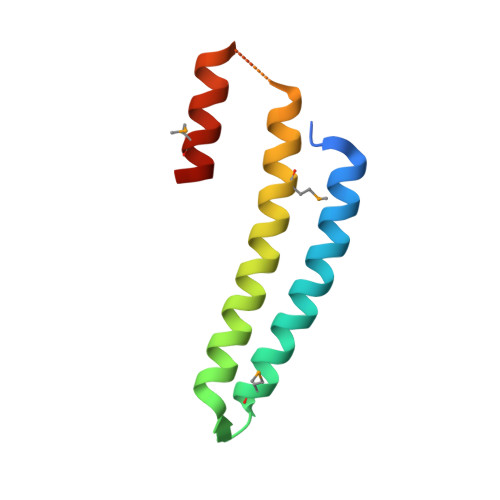Structural and functional characterization of the transcriptional repressor CsoR from Thermus thermophilus HB8
Sakamoto, K., Agari, Y., Agari, K., Kuramitsu, S., Shinkai, A.(2010) Microbiology (N Y) 156: 1993-2005
- PubMed: 20395270
- DOI: https://doi.org/10.1099/mic.0.037382-0
- Primary Citation of Related Structures:
3AAI - PubMed Abstract:
The TTHA1719 gene from Thermus thermophilus HB8 encodes an orthologue of the copper-sensing transcriptional repressor CsoR. X-ray crystal structure analysis of T. thermophilus CsoR indicated that it forms a homotetramer. The structures of the CsoR monomer and dimer are similar to those of Mycobacterium tuberculosis CsoR. In the absence of copper ions, T. thermophilus CsoR bound to the promoter region of the copper-sensitive operon copZ-csoR-copA, which encodes the copper chaperone CopZ, CsoR and the copper efflux P-type ATPase CopA, to repress their expression, while in the presence of approximately an equal amount of copper ion, CsoR was released from the DNA, to allow expression of the downstream genes. Both Cu(II) and Cu(I) ions could bind CsoR, and were effective for transcriptional derepression. Additionally, CsoR could also sense various other metal ions, such as Zn(II), Ag(I), Cd(II) and Ni(II), which led to transcriptional derepression. The copper-binding motif of T. thermophilus CsoR contains C-H-H, while those of most orthologues contain C-H-C. The X-ray crystal structure of T. thermophilus CsoR suggests that a histidine residue in the N-terminal domain is also involved in metal-ion binding; that is, the binding motif could be H-C-H-H, like that of Escherichia coli RcnR, which binds Ni(II)/Co(II). The non-conserved H70 residue in the metal-binding motif of T. thermophilus CsoR is important for its DNA-binding affinity and metal-ion responsiveness.
- RIKEN SPring-8 Center, Harima Institute, 1-1-1 Kouto, Sayo, Hyogo 679-5148, Japan.
Organizational Affiliation:

















